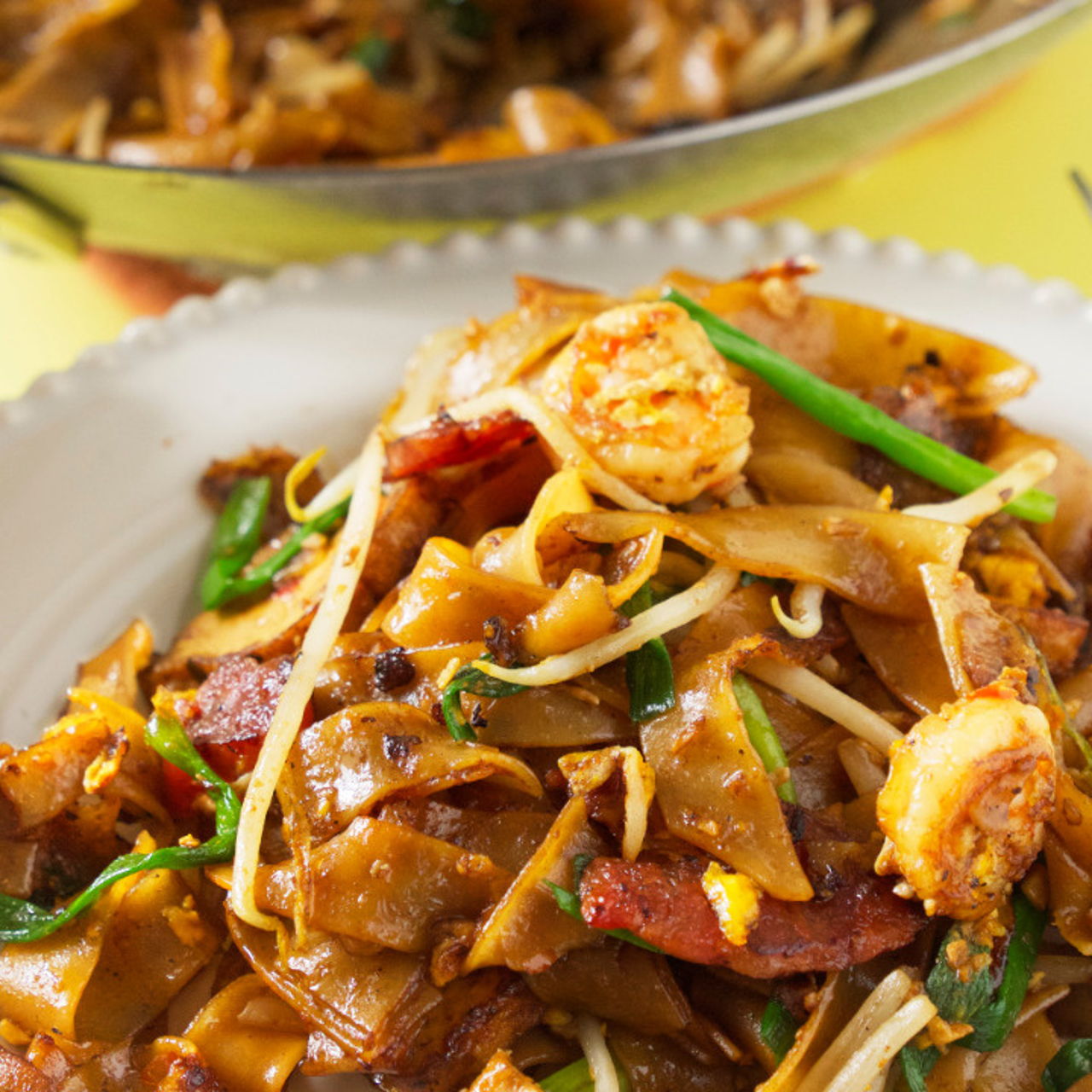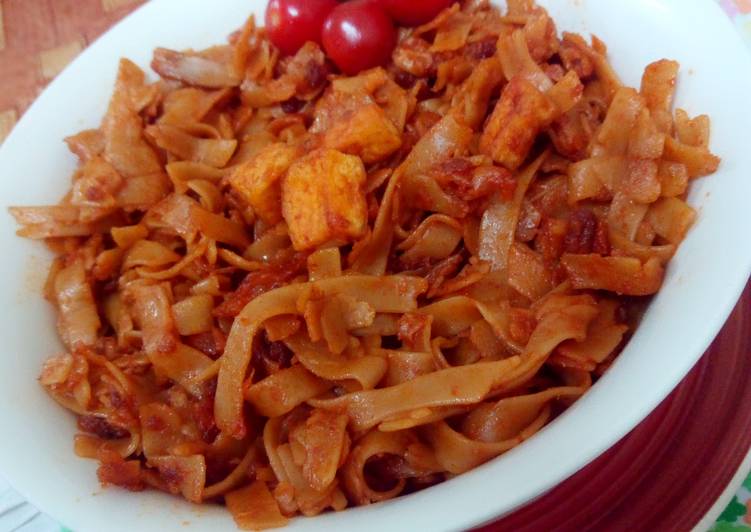Indulge in the tantalizing flavors of kuey teow goreng, a beloved Southeast Asian street food dish. This stir-fried noodle dish boasts a vibrant blend of textures, colors, and aromas that will ignite your taste buds and leave you craving more.
From its humble origins as a hawker stall delicacy to its widespread popularity across the globe, kuey teow goreng has captured the hearts of food enthusiasts worldwide. Join us as we delve into the intricacies of this culinary delight, exploring its ingredients, cooking techniques, variations, and nutritional value.
Ingredients

To create a flavorful and satisfying kuey teow goreng, gather the following ingredients:
Noodles:
- 500g flat rice noodles (kuey teow)
Vegetables:
- 100g bean sprouts
- 100g Chinese cabbage, chopped
- 1 carrot, julienned
Meat or Seafood:
- 200g chicken, sliced
- 200g shrimp, peeled and deveined
- 100g beef, sliced (optional)
Sauce Ingredients:
- 4 tbsp soy sauce
- 3 tbsp oyster sauce
- 2 tbsp chili paste (sambal oelek)
- 1 tbsp sugar
- 1 tbsp sesame oil
- 1 tsp ground white pepper
Cooking
To prepare a mouthwatering plate of kuey teow goreng, embark on the following steps:
Preparing the Noodles
First, soak the rice noodles in warm water for approximately 10 minutes or until softened. Drain the noodles and set them aside.
Preparing the Vegetables and Meat/Seafood
Next, heat a wok or large skillet over medium-high heat. Add a drizzle of oil and stir-fry the vegetables (such as bean sprouts, cabbage, and carrots) until tender-crisp. Remove the vegetables from the wok and set aside.
In the same wok, add another drizzle of oil and cook the meat or seafood (such as chicken, shrimp, or tofu) until browned and cooked through. Remove the meat/seafood from the wok and set aside.
Combining the Ingredients and Cooking
Return the noodles to the wok and stir-fry for a few minutes to heat them through. Add the cooked vegetables and meat/seafood back to the wok and stir-fry until well combined.
Seasoning and Adjusting Flavors
Finally, season the kuey teow goreng to taste with soy sauce, oyster sauce, fish sauce, and sugar. Stir-fry for another minute or two until the noodles are evenly coated and the flavors have blended.
Taste and adjust the seasonings as needed, adding more soy sauce, fish sauce, or sugar to balance the flavors.
Variations and Customization
Kuey teow goreng is a versatile dish that offers endless possibilities for customization. Experiment with different ingredients and techniques to create your own unique version.
Types of Noodles
- Flat rice noodles: The most common type of noodles used in kuey teow goreng.
- Hokkien noodles: Thicker and chewier than flat rice noodles, providing a satisfying bite.
- Yellow wheat noodles: A good substitute for rice noodles, offering a slightly different texture and flavor.
Additional Ingredients
Enhance the flavor and texture of your kuey teow goreng with a variety of additional ingredients:
- Eggs: Scramble or fry eggs and add them to the dish for extra protein and richness.
- Peanuts: Crushed peanuts add a nutty crunch and savory flavor.
- Lime wedges: A squeeze of lime juice brightens the flavors and adds a refreshing touch.
- Bean sprouts: Crisp and refreshing, bean sprouts provide a contrasting texture.
- Chinese chives: These aromatic herbs add a distinct flavor and freshness.
Regional Variations
Kuey teow goreng varies slightly across different regions:
- Malaysian kuey teow goreng: Typically sweeter and uses a darker soy sauce.
- Indonesian kuey teow goreng: More savory and spicy, often incorporating shrimp paste.
Serving and Presentation
To enhance the dining experience, consider these suggestions for serving and presenting kuey teow goreng.
When garnishing, fresh herbs like cilantro and scallions add vibrant colors and a burst of flavor. Crispy fried shallots provide a delightful textural contrast.
Accompanying Dishes
Complement your kuey teow goreng with an array of side dishes that enhance its taste and appeal. Satay, with its savory and slightly spicy peanut sauce, is a popular choice. Pickled vegetables, such as cucumbers or carrots, offer a refreshing contrast and balance out the richness of the dish.
Presentation Ideas
Elevate the presentation by using colorful plates or bowls. Arrange the kuey teow goreng neatly, allowing the vibrant colors of the ingredients to shine through. Garnish with fresh herbs and fried shallots to create a visually appealing dish that tantalizes the senses.
Nutritional Information
Understanding the nutritional value of a dish can guide your dietary choices. Here’s an analysis of the nutritional composition of a serving of kuey teow goreng:
Calories
A serving of kuey teow goreng typically provides around 450-600 calories, depending on the ingredients and serving size.
Macronutrients
- Carbohydrates: The primary macronutrient in kuey teow goreng is carbohydrates, primarily from the flat rice noodles (kuey teow). It provides energy and contributes to the dish’s satisfying texture.
- Protein: Kuey teow goreng contains a moderate amount of protein, mainly from the meat or seafood used. Protein is essential for building and repairing tissues.
- Fat: The dish contains a varying amount of fat, depending on the oil used for cooking and the presence of fatty ingredients like meat or sauces. Fat provides energy and contributes to the dish’s flavor and texture.
Micronutrients
- Vitamins: Kuey teow goreng can provide a range of vitamins, including vitamin C (from vegetables), vitamin B6 (from meat), and vitamin A (from carrots). These vitamins are crucial for various bodily functions, including immunity, metabolism, and vision.
- Minerals: The dish also contains minerals like iron (from meat), calcium (from eggs), and potassium (from vegetables). Minerals are essential for maintaining electrolyte balance, bone health, and red blood cell production.
Closure

Whether you’re a seasoned home cook or a novice culinary adventurer, this guide will empower you to recreate the authentic flavors of kuey teow goreng in the comfort of your own kitchen. Experiment with different ingredients and variations to personalize your dish and embark on a delightful gastronomic journey.
Remember, the true essence of kuey teow goreng lies in its versatility and adaptability, so don’t be afraid to let your creativity shine through.
FAQ Section
What are the key ingredients in kuey teow goreng?
The essential ingredients for a classic kuey teow goreng include flat rice noodles, bean sprouts, cabbage, carrots, meat or seafood of your choice, and a savory sauce made from soy sauce, oyster sauce, and chili paste.
Can I substitute other noodles for rice noodles?
Yes, you can use other types of noodles such as egg noodles, wheat noodles, or even instant noodles. However, the texture and flavor of the dish may vary slightly.
What are some common variations of kuey teow goreng?
Kuey teow goreng has many regional variations. Some popular variations include adding eggs, peanuts, lime wedges, or different vegetables such as bok choy or bell peppers.
Is kuey teow goreng a healthy dish?
The nutritional value of kuey teow goreng can vary depending on the ingredients used. It can be a good source of carbohydrates, protein, and vegetables, but it can also be high in calories and fat if excessive oil is used.
